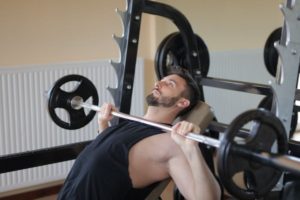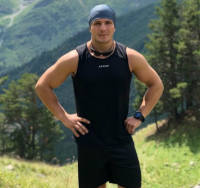Achieving a well-developed and proportionate chest is a common goal for bodybuilders.
However, sometimes they may encounter the frustrating issue of “pointy pecs,” where the chest muscles appear uneven or imbalanced.

Pointy pecs can detract from the desired aesthetic and imbalance the overall physique.
Let’s explore the causes of pointy pecs and provide a comprehensive outline of how to get rid of them.
What are Pointy Pecs?
Pointy pecs refer to an aesthetic concern where the chest muscles appear uneven or asymmetrical, creating a pointed or “puffy” appearance.
It is important to differentiate between pointy pecs and gynecomastia, a condition characterized by the enlargement of breast tissue in males due to hormonal imbalances.
Pointy pecs, conversely, are typically caused by muscle imbalances or uneven development in the chest area.
Difference Between Gynecomastia and Pointy Pecs
It is crucial to distinguish between gynecomastia and pointy pecs, as they require different approaches for resolution.
Gynecomastia is a medical condition that may require consultation with a healthcare professional. It involves the development of glandular breast tissue.
It happens by factors such as hormonal fluctuations, medication side effects, or certain medical conditions.
Pointy pecs are primarily a muscular issue and can often be corrected through targeted training and lifestyle modifications.
Common Factors of Pointy Pecs in Bodybuilders
Bodybuilders may develop pointy pecs due to several factors. One common cause is an imbalance in chest muscle development.
Overemphasis on certain chest exercises, such as an excessive focus on flat bench presses, while neglecting other chest muscles, can lead to excessive growth.
Poor exercise technique, inadequate recovery, and muscle imbalances in other body areas can also contribute to developing pointy pecs.
Understanding these factors is essential for devising an effective plan to address and eliminate pointy pecs in bodybuilders.
Nutrition for Balanced Chest Development
Importance of a Well-Balanced Diet for Overall Physique
Nutrition plays a fundamental role in bodybuilding and achieving balanced chest development.
A well-balanced diet provides the necessary nutrients for muscle growth, repair, and recovery.
It is crucial to consume a variety of nutrient-dense foods to support overall physique goals.
Specific Nutrients Beneficial for Chest Development
Certain nutrients are particularly beneficial.
Protein is vital for muscle repair and growth, so prioritize lean sources like chicken, fish, eggs and plant-based options like tofu or legumes.
Additionally, carbohydrates provide energy for intense workouts.
Incorporating Healthy Fats for Hormonal Balance
Healthy fats are crucial in maintaining hormonal balance, and essential for optimal muscle growth.
Include healthy fats like nuts, seeds, avocados, and olive oil in your diet. These fats also provide a source of long-lasting energy.
Avoiding Caloric Surplus and Fat Gain
While consuming enough calories is necessary for muscle growth, be cautious about excessive caloric, as it can lead to unwanted fat gain, including in the chest area.
Calculate your daily caloric needs and monitor your progress. Adjust your caloric intake to promote lean muscle growth while minimizing fat gain.
Targeted Chest Training

Understanding the anatomy of the chest muscles is crucial for targeted training.
The chest consists of several key muscles, including the minor and the pectoralis major (upper, middle, and lower portions).
Each muscle group has specific functions and can be targeted through different exercises.
Exercises to Develop Specific Areas of the Chest
To address pointy pecs, it is important to incorporate exercises that target the specific areas of the chest that require additional development.
Exercises like incline bench press and incline dumbbell flyes can be effective for the upper chest.
To target the lower chest, incorporate exercises like a decline bench press and dumbbell flyes.
Exercises like flat bench press and dumbbell chest press are beneficial for overall chest development.
Emphasizing Proper Form and Technique
When performing chest exercises, proper form and technique are essential to target the muscles and prevent injury effectively.
Maintain a stable and controlled movement throughout each exercise, focusing on engaging the chest muscles rather than relying on momentum.
Ask for help from a qualified fitness professional to ensure correct form and technique.
Correcting Muscle Imbalances
Identifying Muscular Imbalances to Pointy Pecs
Muscle imbalances, such as overdeveloped or underdeveloped muscles in the chest area, can contribute to the appearance of pointy pecs.
Assess your chest development to identify any noticeable imbalances.
This may involve visually analyzing your physique or seeking the guidance of a fitness professional or coach to provide an objective assessment.
Incorporating Unilateral Exercises for Equal Muscle Development
Unilateral exercises targeting one side of the body at a time can help correct imbalances by allowing the weaker side to catch up in strength and size.
Include exercises like single-arm dumbbell presses, single-arm cable flyes, or push-ups with one hand elevated to ensure each side of the chest works independently.
Utilizing Isolation Exercises for Weaker Muscle Groups
Isolation exercises specifically target individual muscle groups, making them valuable for addressing muscle imbalances.
Include isolation exercises like chest flies, pec-deck flyes, or cable crossovers to isolate and develop the weaker chest areas.
Focus on the mind-muscle connection, emphasizing proper form and contraction to maximize the effectiveness of these exercises.
Cardiovascular Exercise and Fat Loss
Cardiovascular exercise is essential for reducing body fat, including in the chest area.
While spot reduction is not possible, engaging in regular cardio workouts helps burn calories, increase overall energy expenditure, and promote fat loss throughout the body.
This can contribute to a leaner and more defined chest appearance.
Types of Cardio Exercises Suitable for Fat Loss

Include various exercises into your routine to keep it challenging and enjoyable.
Options like running, cycling, swimming, rowing, and high-intensity interval training (HIIT) can elevate your heart rate and increase calorie burn.
Choose exercises you enjoy and can sustain over time to maximize fat loss results.
Incorporating HIIT (High-Intensity Interval Training) For Maximum Results
HIIT involves different periods of high-intensity exercise with short recovery periods. It is highly effective for fat loss and improving cardiovascular fitness.
Include HIIT workouts into your routine 2-3 times per week, utilizing exercises like sprints, burpees, jump squats, or kettlebell swings.
These intense bursts of activity boost metabolism and facilitate fat-burning even after the workout.
Rest and Recovery
Rest and recovery are crucial to any effective training program. Adequate rest allows the body to repair and rebuild muscle tissue, leading to growth and improved performance.
Without proper rest, overtraining and muscle imbalances can occur, hindering progress and potentially exacerbating the appearance of pointy pecs.
Impact of Sleep on Hormonal Balance
Aim for 7-9 hours of uninterrupted, quality sleep each night to support optimal hormone production and regulation.
Hormones like testosterone and growth hormone are crucial for muscle development and recovery.
By prioritizing sufficient sleep, you can maintain healthy hormone levels and promote overall recovery.
Active Recovery Techniques
Active recovery techniques can help alleviate muscle soreness, enhance blood flow, and promote faster recovery.
Consider incorporating activities like foam rolling, stretching, yoga, or light aerobic exercise on rest days to enhance circulation and reduce muscle tension.
Conclusion
Bodybuilders often encounter the challenge of pointy pecs in the quest for a balanced and sculpted chest.
However, by understanding the causes, correcting muscle imbalances, implementing targeted chest training, prioritizing nutrition and fat loss, emphasizing rest and recovery, and seeking professional advice when necessary, bodybuilders can effectively eliminate pointy pecs and achieve a symmetrical and proportionate chest.
Consistency, patience, and a comprehensive approach are the keys to overcoming this obstacle and attaining the desired chest development that enhances the overall physique.

I was working as a mountain guide, probably all around the planet. One day, I met my wife in the mountains, literally on top of the world. Now, I have a beautiful family and three kids, so I don’t have much time for climbing, but sometimes I go camping with my friends. I am also into gym workouts, and I can’t imagine my life without sports.
Since I ended my professional career as a climbing guide, I’ve been giving personal classes and helping amateurs to get ready for conquering their first peaks. Also, that’s how the whole blog idea appeared.





